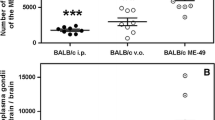Abstract
The tissue responses against Cladosporium trichoides and its parasitic forms were studied using nude (nu/nu) mice and their heterozygous (nu/+) littermates of BALB/c background.
1.0,0.1 and 0.01% cell suspensions were prepared from a culture broth which had been inoculated with the C. trichoides and cultured with reciprocal shaking at 27 ° C for 7 days. Sixty nu/nu or 60 nu/+ mice were divided into three groups consisting of 20 each which was allotted to one of the three cell suspensions. Each mouse was inoculated intravenously with 0.1 ml of either the cell suspensions. Two mice from each of the six groups were sacrificed at adequate intervals until 30 days after inoculation and histopathologic sections stained with H & E or by PAS were prepared from their visceral organs.
There were no characteristic findings in the nu/nu and nu/+ mice inoculated with the 0.01% cell suspension. When inoculated with the 1.0% cell suspension, the brain was the favorite target organ in both groups of mice and the kidney was the second. When inoculated with the 0.1% cell suspension, brain lesions were observed only in the nu/nu mice. The susceptibility of the nu/nu mice was higher than that of the nu/+ mice.
The parasitic forms in the brain of the nu/nu and nu/+ mice were slender septate true hyphae with or without polymorphonuclear leucocyte infiltrate, while in the liver, spleen and lung of both groups of mice the parasitic forms were short thick hyphae, moniliform hyphae, chlamydospores or round cells (sclerotic cells). Many giant cells containing fungal elements appeared in the liver of the nu/nu mice.
Similar content being viewed by others
References
Amma, S. M., C. K. J. Paniker, P. T. Iype & S. Rangaswamy, 1979. Phaeohyphomycosis caused by Cladosporium bantianum in Kerala (India). Sabouraudia 17:419–423.
Aravysky, R. A. & V. B. Aronson, 1968. Comparative histopathology of chromomycosis and cladosporiosis in the experiment. Mycopathol. Mycol. Appl. 36: 322–340.
Bennett, J. E., H. Bonner, A. E. Jennings & R. I. Lopez, 1973. Chronic meningitis caused by Cladosporium trichoides. Am. J. Clin. Pathol. 59: 398–407.
Binford, C. H., R. K. Thompson & M. E. Gorham, 1952. Mycotic brain abscess due to Cladosporium trichoides, a new species. Am. J. Clin. Pathol. 22: 535–542.
Chrichlow, D. K., F. T. Enrile & M. Y. Memon, 1973. Cerebellar abscess due to Cladosporium trichoides (bantianum): Case report. Am. J. Clin. Pathol. 60: 416–421.
Dixon, D. M., H. J. Shadomy & S. Shadomy, 1980. Dematiaceous fungal pathogens isolated from nature. Mycopathologia 70: 153–161.
Duque, P., 1961. Meningo-encephalitis and brain abscess caused by Cladosporium and Fonsecaea. Review of the literature, report of two cases, and experimental studies. Am. J. Clin. Pathol. 36: 505–517.
Felger, C. E. & L. Friedman, 1962. Experimental cerebral chromoblastomycosis. J. Infect. Dis. 111: 1–7.
Hironaga, M. & S. Watanabe, 1980. Cerebral phaeohyphomycosis caused by Cladosporium bantianum: A case in a female who had cutaneous alternariosis in her childhood. Sabouraudia 18: 229–235.
Kwon-Chung, K. J. & G. A. de Vries, 1983. Comparative study of an isolate resembling Banti's fungus with Cladosporium trichoides. Sabouraudia 21: 59–72.
McGinnis, M. R. & D. Borelli, 1981. Cladosporium bantianum and its synonym Cladosporium trichoides. Mycotaxon 13: 127–136.
Middleton, F. G., P. F. Jurgenson, J. P. Utz, S. Shadomy & H. J. Shadomy, 1976. Brain abscess caused by Cladosporium trichoides. Arch. Intern. Med. 136: 444–448.
Nishimura, K. & M. Miyaji, 1981. Defense mechanisms of mice against Fonsecaea pedrosoi infection. Mycopathologia 76: 155–166.
Nishimura, K. & M. Miyaji, 1983. Defense mechanisms of mice against Exophial dermatitidis infection. Mycopathologia 81: 9–21.
Riley, O. & S. H. Mann, 1960. Brain abscess caused by Cladosporium trichoides. Review of 3 cases and report of fourth case. Am. J. Clin. Pathol. 33: 525–531.
Author information
Authors and Affiliations
Rights and permissions
About this article
Cite this article
Nishimura, K., Miyaji, M. Tissue responses against Cladosporium trichoides and its parasitic forms in congenitally athymic nude mice and their heterozygous littermates. Mycopathologia 90, 21–28 (1985). https://doi.org/10.1007/BF00437269
Issue Date:
DOI: https://doi.org/10.1007/BF00437269




